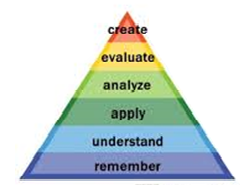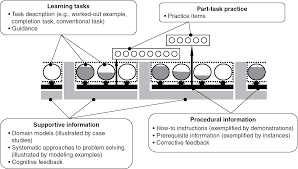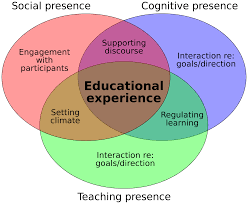Instructional Design Resources
The instructional design (ID) team provides consultative and collaborative resources for faculty members to improve and polish instructional content and strategies. The collection of ID resources will cover Learning Objectives, Instructional Materials, and Assessment these 3 aspects.
- Learning Objectives:
Learning objectives or desired learning outcomes are very important in online learning environment as they play the role of road maps for students. Two types of learning objectives could be included in the course syllabus and learning modules: course-level learning objectives and module-level learning objectives. Clear and logical learning objectives would help learners build connections between the course structure, assigned learning activities, and assessments.
- Bloom’s Taxonomy and the verbs associated with its different levels of assessing knowledge and comprehension would be a great tool for instructors to create measurable learning objectives or refine the learning objectives. If you would like to learn more about Bloom’s Taxonomy, please visit https://cft.vanderbilt.edu/guides-sub-pages/blooms-taxonomy/

- Another helpful tool is the Objectives Builder from Arizona State University https://teachonline.asu.edu/objectives-builder/. With this interactive tool, you could generate measurable learning objectives within minutes. You could also copy and paste the list of learning objectives to the course syllabus or any learning module that you would like to present the objectives. This tool is run by Adobe Flash Player, which suggests that the tool would be compatible with PC users but not Mac users. For PC users, please make sure that you install the latest Adobe Flash Player on your computer and allow it to open in the web browser you are using.
- Instructional Materials
Our ID team help with course design but not course delivery. We trust our faculty members have the best judgements on the quality of instructional materials.
Textbooks from the publishers along with the online homework management systems would provide students with diverse learning resources and content. But, they might also be costly http://www.nbcnews.com/business/business-news/students-are-still-saddled-soaring-textbook-costs-report-says-n516011. FHSU ID team are collaborating with the librarians at the Forsyth Library to research free and open educational resources (OER) for our faculty members. Please contact tigerlearn@fhsu.edu or our OER librarian Claire Nickerson cenickerson@fhsu.edu if you would like to get involved or inquire further information.
We highly recommend instructors to provide diverse learning materials with students, such as videos, PowerPoint slides, and digital literacy. As learners process information through visual and auditory channels, instructors are highly recommended to provide interactive learning materials that would engage students with different learning preferences and thus, to optimize the learning outcome.
Several learning theories and instructional design models might help you get started with resource accumulation.
- Cognitive Theory of Multimedia Learning
People process information via visual and auditory channels https://en.wikiversity.org/wiki/Cognitive_Theory_of_Multimedia_Learning With the purpose of delivering efficient and effective information to learners, educators and practitioners might consider multimedia learning principles when they present the learning content to learners.
- 4C/ID Model
This is an instructional design model that would help you frame complex learning environments. This ID model is problem-based and very useful for courses that aims to teach students skillsets http://edutechwiki.unige.ch/en/4C-ID. It has been widely used in science, technology, engineering, and mathematics (STEM) disciplines as these majors require students to learn from hand-on activities.

- Community of Inquiry (COI) Model

- Assessment
Designing assessment is ongoing complex and systemic process that gathers and interprets students' performance by the faculty to measure students' success. Therefore, to create effective assessment requires the instructor to reflect, systemically review, document, and assess the students' performance.
One of the consideration when creating an assessment is teaching environment such as face to face, Online, or blended. Different teaching environments offer a unique challenge to creating assessments. Therefore, selecting an appropriate technique and tool for assessment that works for the specific teaching is important.
https://www.kent.ac.uk/teaching/assessment/documents/Assessment-Design-Cycle-diagram.pdf
"Assess Teaching & Learning Resources" from Carnegie Mellon University offer great information on Assessments. This resource site provides basic information about the assessments, such as designing different types of assessments with checklist and sample rubrics.
https://www.cmu.edu/teaching/assessment/index.html
A rubric is a great way to systemically measure students' performance, but creating a rubric from scratch can be a daunting task.
This PowerPoint provides a basic overview of rubrics and an example of blackboard rubric.
iRubric is a comprehensive rubric development, assessment, and sharing tool. Designed from the ground up. iRubric supports a variety of applications in an easy-to-use package. Best of all, iRubric is free to individual faculty members and students.
"VALUE Rubrics" is from Association of American Colleges & University. It has a lot of quality sample rubrics.
https://www.aacu.org/value-rubrics